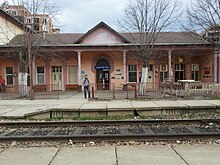Pristina railway station
Pristina Prishtinë Priština / Приштина | |
|---|---|
 The station frontage in 2009 | |
| Location | Tirana Boulevard Pristina Kosovo[a] |
| Coordinates | 42°39′32″N 21°09′04″E / 42.658934°N 21.151067°E / 42.658934; 21.151067Coordinates: 42°39′32″N 21°09′04″E / 42.658934°N 21.151067°E / 42.658934; 21.151067 |
| Platforms | 2 |
| Tracks | 2 |
| History | |
| Opened | 1936 (1936) |

The station building from the platform, March 2014
Pristina railway station (Albanian: Stacioni i trenit në Prishtinë, Serbian: Приштинска железничка станица, translit. Prištinska železnička stanica) is the central railway station in the city of Pristina, the capital of Kosovo. It opened on Tirana Boulevard (formerly 'Omladinskih Brigada') in 1936, having been constructed by a French/British company.[1] Trains calling at the station are operated by Trainkos sh.a.
The line on which the station sits is single-track, laid to standard gauge, but there is a loop at the station, allowing trains to pass there, with a second, parallel, loop lying out-of-use as of October 2016.
A daily international train runs between Pristina and Skopje, in Macedonia.
Pristina is also served by the larger Kosovo Polje railway station at nearby Kosovo Polje.
Events
During the era when Kosovo was part of the Socialist Federal Republic of Yugoslavia, the country's leader Marshall Tito occasionally visited Pristina, arriving on his personal Blue Train.[1]
During the 1999 Kosovo War, Serbian and Yugoslav regular forces, in conjunction with paramilitaries, conducted large-scale ethnic cleansing of ethnic Albanian inhabitants of Pristina through the station. Many of those expelled were directed onto trains apparently brought there for the express purpose of deporting them to the border of the Republic of Macedonia, where they were forced into exile.[2]
.mw-parser-output .templatequote{overflow:hidden;margin:1em 0;padding:0 40px}.mw-parser-output .templatequote .templatequotecite{line-height:1.5em;text-align:left;padding-left:1.6em;margin-top:0}
On, or about, 1 April 1999, Serbian police went to the homes of Kosovo Albanians in the city of Pristina/Prishtinë and forced the residents to leave in a matter of minutes. During the course of Operation Horseshoe, a number of people were killed. Many of those forced from their homes went directly to the train station, while others sought shelter in nearby neighbourhoods. Hundreds of ethnic Albanians, guided by Serb police at all the intersections, gathered at the train station and then were loaded onto overcrowded trains or buses after a long wait where no food or water was provided. Those on the trains went as far as Đeneral Janković, a village near the Macedonian border. During the train ride many people had their identification papers taken from them.[3]
— War Crimes Indictment against Milošević and others
The station was restored by British soldiers, serving as part of KFOR, later in 1999.[4]
Notes
^ Kosovo is the subject of a territorial dispute between the Republic of Kosovo and the Republic of Serbia. The Republic of Kosovo unilaterally declared independence on 17 February 2008, but Serbia continues to claim it as part of its own sovereign territory. The two governments began to normalise relations in 2013, as part of the Brussels Agreement. Kosovo has received formal recognition as an independent state from 113 out of 193 United Nations member states, of which several have been revoked.
References
| Wikimedia Commons has media related to Pristina train station. |
^ ab A'Mula, Shega (16 February 2009). "All Aboard! :: Balkan Insight". Balkan Insight. Retrieved 27 October 2016..mw-parser-output cite.citation{font-style:inherit}.mw-parser-output q{quotes:"""""""'""'"}.mw-parser-output code.cs1-code{color:inherit;background:inherit;border:inherit;padding:inherit}.mw-parser-output .cs1-lock-free a{background:url("//upload.wikimedia.org/wikipedia/commons/thumb/6/65/Lock-green.svg/9px-Lock-green.svg.png")no-repeat;background-position:right .1em center}.mw-parser-output .cs1-lock-limited a,.mw-parser-output .cs1-lock-registration a{background:url("//upload.wikimedia.org/wikipedia/commons/thumb/d/d6/Lock-gray-alt-2.svg/9px-Lock-gray-alt-2.svg.png")no-repeat;background-position:right .1em center}.mw-parser-output .cs1-lock-subscription a{background:url("//upload.wikimedia.org/wikipedia/commons/thumb/a/aa/Lock-red-alt-2.svg/9px-Lock-red-alt-2.svg.png")no-repeat;background-position:right .1em center}.mw-parser-output .cs1-subscription,.mw-parser-output .cs1-registration{color:#555}.mw-parser-output .cs1-subscription span,.mw-parser-output .cs1-registration span{border-bottom:1px dotted;cursor:help}.mw-parser-output .cs1-hidden-error{display:none;font-size:100%}.mw-parser-output .cs1-visible-error{font-size:100%}.mw-parser-output .cs1-subscription,.mw-parser-output .cs1-registration,.mw-parser-output .cs1-format{font-size:95%}.mw-parser-output .cs1-kern-left,.mw-parser-output .cs1-kern-wl-left{padding-left:0.2em}.mw-parser-output .cs1-kern-right,.mw-parser-output .cs1-kern-wl-right{padding-right:0.2em}
^ "Kosovo Albanians 'driven into history'". BBC. April 1, 1999. Retrieved February 1, 2013.
^ "Indictment against Milosevic and others". Americanradioworks.publicradio.org. Retrieved 2010-07-04.
^ Marcus, Jonathan (17 July 1999). "The Kosovo Express". BBC Online. Retrieved 27 October 2016.